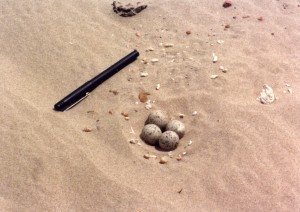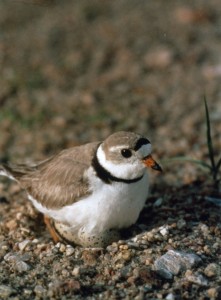“Sharing the Shoreline” at Lake McConaughy

Summer’s arrival (technically on June 21) means the beaches at Lake McConaughy are once again attracting crowds of visitors to enjoy the warm weather, swimming, camping and many other recreational pursuits. It also means the return of another group of visitors — piping plovers and interior least terns – two species of shorebirds that build nests and raise chicks on the beaches of Nebraska’s largest reservoir.
Piping plovers are a small (five to six inches long) sand-colored bird with a white breast and a single dark ring around the throat. Smaller than a robin, plovers have orange legs and an orange bill with a black tip. They are also recognizable by their “peep-lo” whistle, a sound beach-goers may hear before they can see the small and well camouflaged birds. Another characteristic that can aid in identification is the “broken wing” act the parent birds perform when an intruder nears their nests. The birds will feign injury, hoping to draw the intruder away from the nests and chicks.
Like piping plovers, interior least terns build nests by scraping out a small bowl in the sand in which to lay eggs. Least terns are small (eight to nine inches) gray-white birds with black outer wing tips and yellow legs and bills. The tail is slightly forked and the head is capped with a black patch of feathers above a white forehead. Least terns are more aggressive in defense of their nests, diving at predators and often dropping excrement on anyone or anything that draws to close.
Piping plovers and least terns are already present and tending their nests, so it is once again time for Big Mac visitors to being the annual practice of “Sharing the Shoreline.” Although the nesting process is a little behind normal this year because of cool, damp conditions during the spring, the number of nests is expected to increase over the coming days. There are, as of June 11, five large enclosures in which a number of nests are located, two on the south shore and three on the north. Nests may also be located in other areas outside the existing enclosures.

Plover nest at Lake McConaughy
Predation and severe weather are the most common causes of nest and chick loss among the species, but human disturbance can also result in nest destruction. Central locates and marks the birds’ nesting areas, so if visitors see signs or temporary fencing that indicate the presence of the birds and their nests, please avoid those areas. Also, remember to keep pets on leashes at all times when on the beaches and campgrounds. Failure to do so is a violation of a Nebraska Game and Parks Commission regulation and – since plovers are listed as threatened species and terns as endangered species under the Endangered Species Act – disturbance of nests or birds can result in a fine, jail term, or impoundment of any vehicle used in a nest disturbance. The best action to take upon encountering a nest site is to AVOID IT COMPLETELY!
Please help protect the birds and preserve Lake McConaughy’s beaches as the outstanding place for outdoor recreation that they are by “SHARING THE SHORELINE!”


Leave a Reply